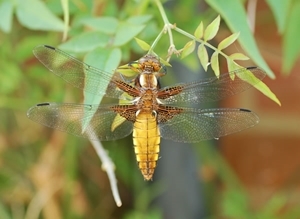Broad-bodied chaser dragonfly
 Dragonflies belong to the order called Odonata, which means “toothed jaws”. There are around 5,900 dragonfly species worldwide, with most living in the tropics. Europe does have about 120 species, however, and around 45 of these breed in Britain and Ireland.
Dragonflies belong to the order called Odonata, which means “toothed jaws”. There are around 5,900 dragonfly species worldwide, with most living in the tropics. Europe does have about 120 species, however, and around 45 of these breed in Britain and Ireland.
Dragonflies flew about in humid carboniferous forests some 300 million years ago and fossil records tell us that a few of them were enormous in size, with a wingspan of over two feet! Dragonflies are aerodynamically amazing, as they can beat their two sets of wings out of phase, which enables them to fly not only forwards, but also backwards and to change direction in an instant. They can also hover and glide for long periods.
There are three stages in the life-cycle of a dragonfly. Eggs hatch into larvae (also known as a nymph), which then goes through a series of moults (up to 18 times depending on the species and conditions) before eventually emerging as an adult. These nymphs are serious predators on other water life, waiting in hiding for an unsuspecting small fish or tadpole to swim by, so that it can pounce and grab the unfortunate prey in its serrated jaws.
Unlike most other insects, there is no pupal stage and the transition from larva to adult is known as incomplete metamorphosis. This is not necessarily an annual cycle, since the larva may spend more than a year underwater before emerging as an adult. The adult dragonfly only lives for a few weeks at best, so it is important that it synchronises with others of its kind to ensure that mating takes place.
Final-stage larvae sit in shallow water near the margins for several days and start to breathe air. Once the larvae have a complete, fully formed adult within, they will climb up robust emergent vegetation, although some may walk several metres over dry land before finding somewhere suitable. After finding a secure support, they redistribute their body fluids – first to push the thorax, head, legs and wings out of the larval skin.
There is then a pause of about 30 minutes to allow their legs to harden enough for the next stage, when the abdomen is also withdrawn. The wings and then the abdomen are expanded and start to harden. This process leaves behind the larval cast skin which is called an exuvia (a great scrabble word!) and the whole procedure can last up to three hours.
The broad-bodied chaser is a widespread and common dragonfly in the southern half of England and Wales, and can sometimes be found many miles away from water. It is this lust for wandering which often means that it is the first to turn up at a newly created pond, where it will stake out its territory, fending off all other male dragonfly intruders, whilst also preying on flies, midges and mosquitoes to keep its energy levels up. The male has a wonderful sky blue abdomen with yellow spots along the side, while the female (and immature males) is yellowish brown in colour.
If you are reading this in Scotland, then you might well be thinking that I should have picked a dragonfly species that lives in Scotland, so that you can go in search of it too! Well, a number of dragonfly species are definitely moving their distribution northwards, probably as a result of climate change, so it may not be long before you get to see this species in your part of the world.
Also, you do have dragonfly species – such as the lovely Azure Hawker dragonfly, that the English and Welsh will need to jump into a car to see, as it is only found in Scotland!
So, wherever you live, choose a warm sunny day and take a wander down to your nearest freshwater, whether it be in the form of river, canal, lake or pond and see what dragonfly species you can spot. You will not be disappointed by just how amazing these creatures are!
Peter Thompson
Advisory
Read more from Peter Thompson at his blog.

Download Peter Thompson's essential 26-page book, featuring beautiful photography and detailed profiles of Britain's wildlife
Download FREE >